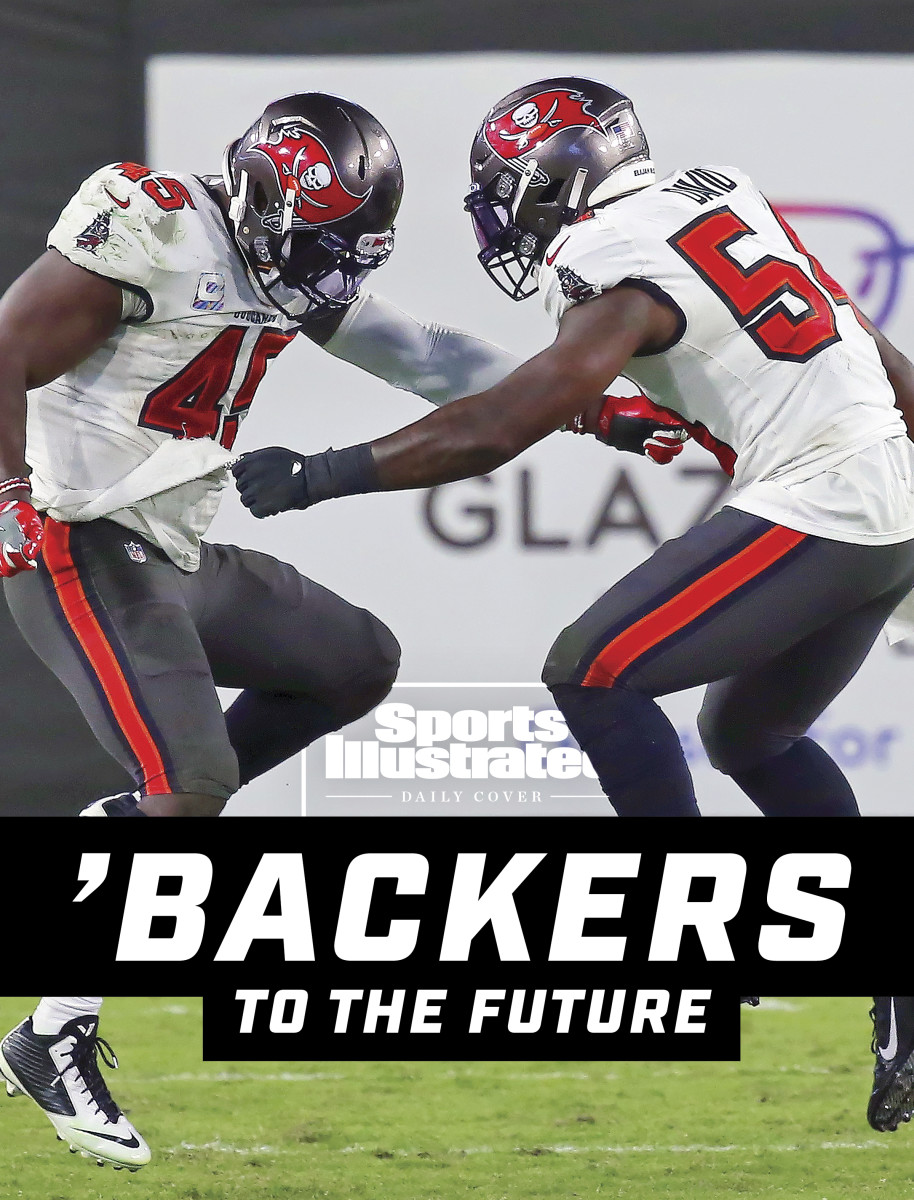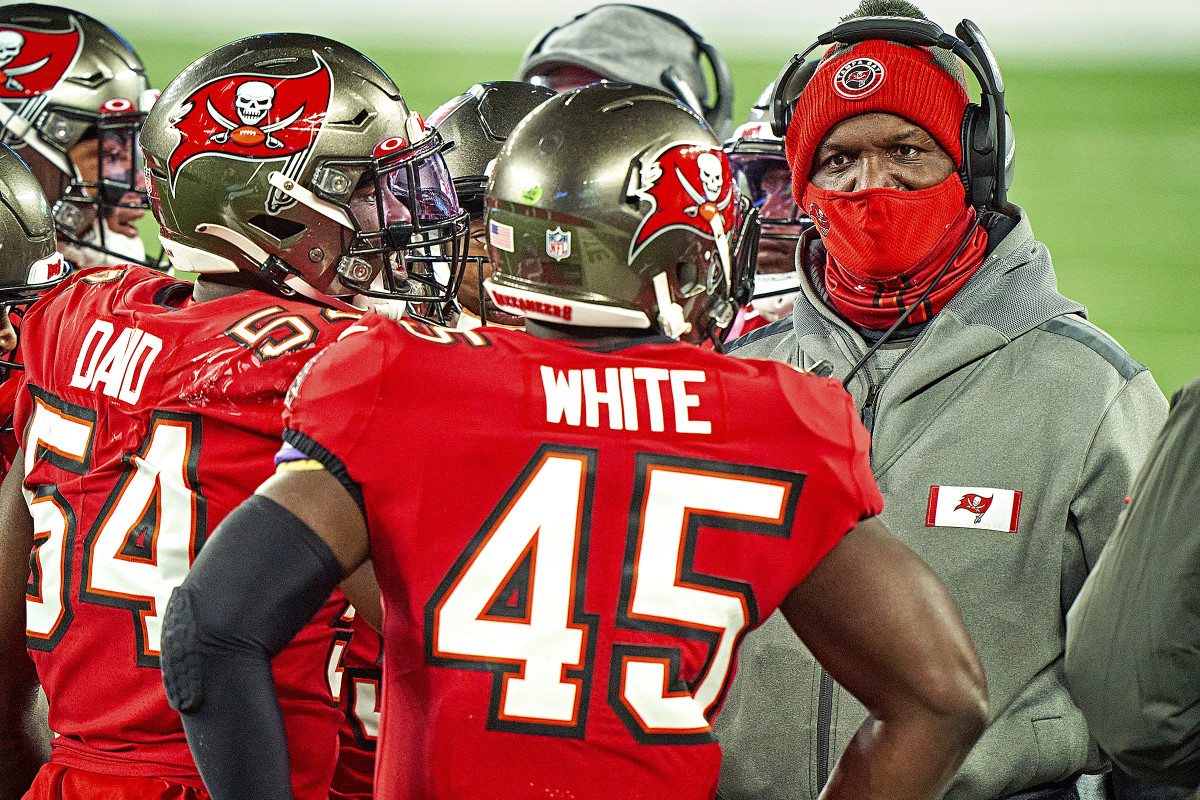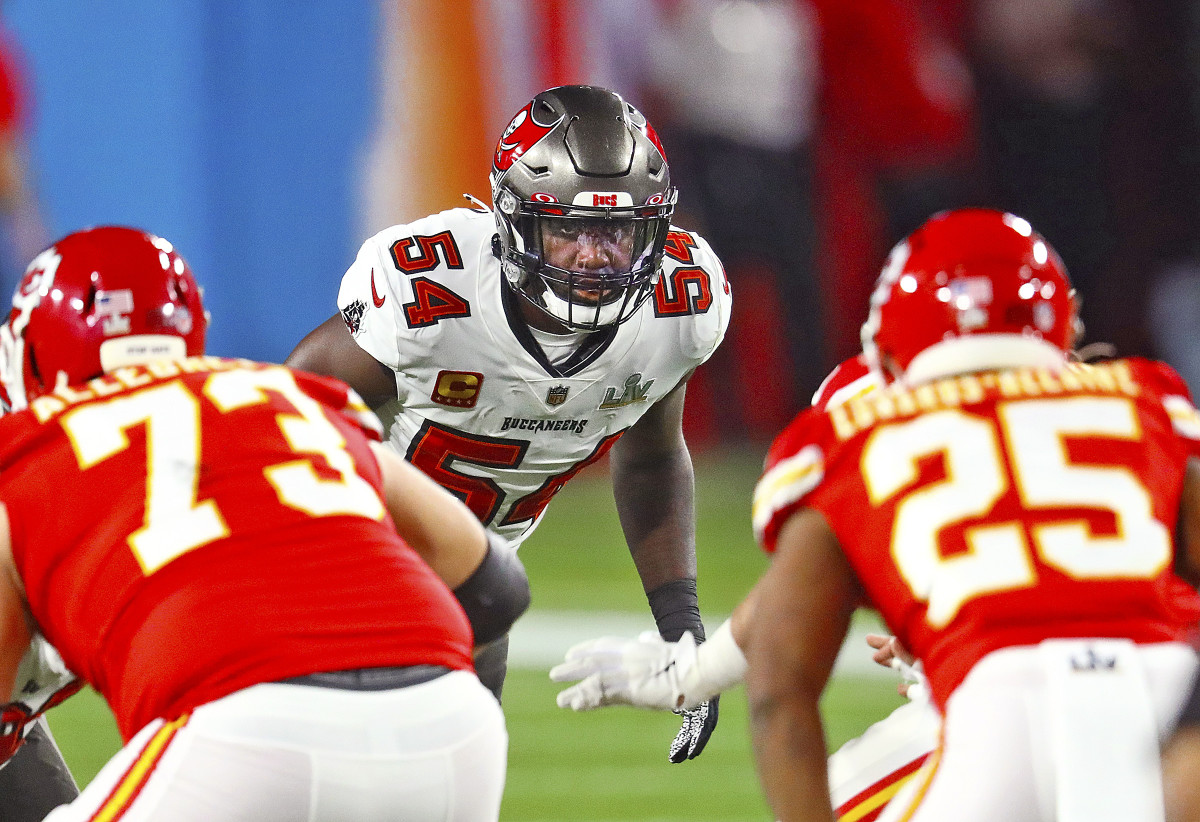How the Bucs Are Leading a Linebacker Revival
Todd Bowles seldom breaks character, but when he does, his wit is almost artful. To hear it from Buccaneers players, the juxtaposition between the 57-year-old defensive coordinator’s usually stoic demeanor and his situationally droll one-liners explains why his jokes tend to land so well.
Veteran linebacker Lavonte David is a frequent target. He once bragged to Bowles that he possessed supreme pass-catching skills, but after his second dropped interception last season Bowles began the next meeting by casually asking the former Pro Bowler: “You need to borrow my hands today?”
“Lavonte said he had ‘hands like Allstate,’ ” Bowles recalls, referencing the omnipresent ad campaign based around those ever-reliable, open palms. “I come to find out he needs the insurance himself.”

Like the best jokes, there lies an implied truth here. Bowles expects that his linebackers David, 31; and his 23-year-old partner on the second level, Devin White; are capable of catching the football. That’s in addition to covering tight ends, running backs and wide receivers just as well as Bowles himself did during his time as an NFL defensive back in the 1980s. When the trio first started working together two years ago, Bowles laid out his expectations. Simply put: “Blitz and cover, blitz and cover, blitz and cover” (while, obviously, maintaining the physicality necessary to stop the run).
Since then, David and White have blitzed, covered and tackled as well as any linebacker duo in the NFL. And the result has been a Super Bowl–winning defense with the ability to do what so many coordinators across the league can only wish for: keep linebackers on the field to defend against the run, while not becoming susceptible to passing-game mismatches. So often in today’s NFL, linebackers are targeted by opponents who force them to cover faster pass-catchers. Offenses tend to use a no-huddle, hurry-up approach when the defense—unable to substitute between plays—is “stuck” with multiple linebackers on the field. Tampa Bay has the antidote.
“When the other team goes no-huddle, I already have two guys [on the field] in there that can play,” says Bowles, speaking of David and White, the only linebacking duo who each played at least 93% of their unit’s snaps in 2020.
Tampa Bay’s success since hiring Bowles and drafting White fifth in 2019, to pair with David, has raised antennae and shifted aspirations across the league. At the 2020 draft, the number of off-ball linebackers (as opposed to stand-up edge rushers, who are often considered outside linebackers but play a different role), drafted in the first round doubled from the year before. After the Bucs’ win over the Chiefs in Super Bowl LV in February, the Cardinals, Cowboys and Washington each added off-ball linebackers in the first round, hoping to create a dynamic similar to what Bowles has in Tampa Bay.
David sees it: His position is experiencing a bit of a renaissance. Inside linebackers are getting their due, too, with earnings more in line with edge rushers (whose splashy deals have typically reflected their generating of sacks and quarterback pressures). The Colts recently made Darius Leonard the highest-paid inside linebacker in NFL history, with a contract that averages $19.7 million per season. And that only barely eclipsed the $19 million per season that the 49ers committed to Fred Warner a few weeks earlier. (For perspective, both deals rank among the 15 highest for any defensive player.) In March, David signed his own two-year, $25 million contract extension, which is significant for an inside linebacker in his early 30s. And Bowles, for good measure, in August accepted a three-year extension (one year longer than most coordinator contracts) that will make him the highest-paid defensive coordinator in football.
But the real story of this linebacking renaissance is, like any other evolution in the NFL, a matter of expert timing and keen resource-mining. Teams that quickly followed Bowles and the Bucs will be prepared for what is happening now and well into the near future.
“People were starting to devalue the position,” David says. “We put respect back on the linebacker. [Coaches] are trying to take us off the field on certain downs, but when you have guys like me and Devin, that just raises our value. We’re upholding the position.”
Over the past two decades, as rule changes prompted an explosion in the passing game, general managers and defensive coaches reacted the way one might expect: They overdrafted and oversigned stud defensive backs to compensate for the myriad ways in which their secondaries were being carved up.
And because there are only so many ways to build a roster under the salary cap, that influx of investment in defensive backs had to come at the expense of some other position. Defenses were running more dime personnel (six defensive backs), and they often siphoned resources from the linebackers’ room to do so, since linebackers suddenly weren’t playing as much.
In response, some offenses in recent years began to capitalize on the fact that their opponents were critically overmatched from a run-defense standpoint. These teams began deploying heavier formations—using a second tight end or a fullback instead of a third receiver—which forced defenses to put two or three linebackers (from that same depleted position group) back on the field more frequently. The latest in a series of chess moves raised two major issues for defenses.
• The third off-ball linebacker on a given team was often one of the worst players on the roster. Most defenses were much deeper in quality defensive backs. A defensive coordinator couldn’t put his best 11-man lineup on the field.
• Defenses became so used to playing in pass-oriented sets that they prepared fewer play calls for linebacker-heavy personnel groupings. They weren’t just physically overmatched—they’d also become predictable.
“Common sense: If every defense in the league starts going light, starts playing dime and nickel for the bulk of the snaps; at some point [offenses] are going to line up and power you,” says one AFC personnel man. “You need someone to stop the bleeding—guys who can match that physicality and strength.”
The advantage of enticing a defense into playing its third linebacker instead of its fifth defensive back might seem thin, but it can net massive gains for an opponent, and it has fueled offenses in Baltimore, Green Bay, New England, San Francisco and Tennessee, among others. Despite differences at quarterback and in offensive scheme, those teams all thrive by forcing opponents into linebacker-heavy sets.

This all works to accentuate versatile inside linebackers such as David and White, who, according to NFL Game Statistics and Information System, last season saved the Bucs 467.4 total rushing yards and 483.3 total passing yards by virtue of being on the field. (That stat, called “net yards over average,” calculates a player’s value on a per-play basis, measured against a league-average player at the position.) David, specifically, has been the gold standard for coverage among his peers; according to NFL Next Gen Stats, he has the third-highest coverage-success rate since 2019, the fourth-best yards per target allowed and the second-best yards after catch per reception allowed.
“There is a lot of [offensive] variety in the league right now,” says Jets coach Robert Saleh, the longtime defensive coach who served as coordinator of the 49ers’ D the past four seasons. “And you have to be able to handle all of it.”
Saleh says he was fortunate in recent years to practice against Kyle Shanahan, who was early to the trend of manipulating opposing defenses for the sake of exposing shoddy linebacker play. He has seen the breadth of tricks up close, and he can counter schematically—but absent a linebacker with the duality of David and White, that scheming could ultimately end up fruitless.
The long-term availability of those types of players remains to be seen. One AFC personnel man, for example, observes that most linebackers coming out of college have range from sideline to sideline (the nature of the college game, which now sees plenty of tight ends who can run 4.4 40-yard dashes, has forced the position to adapt.) But the search grows complicated from there. Can that same player shed a block and get a 220-pound runner to the ground? Can he stick with Travis Kelce and throttle Derrick Henry behind the line of scrimmage?
“If you can hit dudes in the mouth, that’s a big bonus,” says the AFC personnel man. But, he warns: It’s not something that can be taught. “God gives you that.”

The primary narrative of Tampa Bay’s Super Bowl victory in February centered on Tom Brady, the ageless quarterback who left the comforts of a Patriots dynasty and conjured up a championship with a franchise known more for losing.
But a deeper look at the Bucs’ stunning 31–9 win over the Chiefs suggests that Bowles’s pass rush—which hit Patrick Mahomes 10 times and sacked him three times, and which logged more quarterback pressures than any defense in Super Bowl history—deserves just as much of the acclaim.
To pull off that feat, David and White had to play a nearly perfect game against Kansas City, whose armada of pass-catching weapons provides the ideal scenario for Mahomes on almost every snap. Although he is known as a theatrical deep ball passer, the quarterback’s intermediate-level targets—those darts fired 5 to 10 yards beyond the line of scrimmage—are the engine that drive the Chiefs’ offense. That is because, with defensive backs retreating to defend the deep ball, linebackers are often left on an island.
Against Tampa Bay, however, so many of Mahomes’s dropbacks resulted in some kind of confusion or hesitation. Obviously, a pass rush was coming—but, for the most part, he couldn’t get the ball out of his hands because those intermediate targets, so used to operating in open spaces, were suddenly boxed in by David and White.
Mahomes would drop back and watch as his receivers started dragging across the middle, anticipating a linebacker mismatch. But there was David, flipping his hips from an awkward coverage position to place himself in front of Kelce, sometimes even in single coverage. Or there was White, locating running back Darrel Williams out of the backfield and closing the 5-yard gap in a split second, leading Mahomes to panic-roll toward the sideline and sidearm the ball out of bounds.
“We talk every day,” Bowles says of his relationship with David over the past two years. “About the how, what, why, where and when; about how everybody fits and where everybody fits.” Soon enough, David was taking what he’d learned and coaching it on the field. “He’s teaching guys, and everyone runs the defense, not just what I call.”
It’s a stark contrast from what David experienced just a few years ago. Linebacking, he admits, was losing its joy. And other linebackers around the league, he says, told him the same thing. They would do all the work and receive none of the credit. They were gassed and forced out of position, and they weren’t consistently involved in any of the glamorous aspects of the defense, like hitting the quarterback or ball-hawking in the secondary. “We’re looking at each other like, Nah, this can’t be us,” David says. “We can do the same things they’re doing but better.”
When Bowles arrived, in 2019, David was ready for something new, and he began peppering the incoming coordinator with questions about how his scheme would work. Where would David fit in a base 3–4 defense that was unlike anything he’d ever played in before?

Bowles says the intention wasn’t to create a scheme to maximize David. He cites an old saying from his mentor, Bill Parcells: “Let giraffes be giraffes and elephants be elephants.” In David, Bowles saw a linebacker capable of doing more than he’d been asked in the past, and he saw a similar talent in White. He let his imagination do the rest. David is a Bucs lifer, a second-round draft pick in 2012. It wasn’t until January that he finally appeared in a playoff game. Four weeks later, he was lifting the Lombardi Trophy.
When the upcoming season kicks off, there will no doubt be plenty of teams still hoping to survive with smaller, faster defensive players, lacking the heft to hold up against a power running game. Or with sturdy linebackers absent the versatility to handle themselves in coverage.
Bowles will still be cracking jokes. Those other defensive coordinators, though, may not be in the mood.
• Copycatting the NFL’s Trendiest Offense Is Harder Than You Think
• How Derrick Henry Handles a Workload That Should Ruin Him
• Dak Prescott’s Heal Turn
• The NFL’s Problems With the Deshaun Watson Investigation
